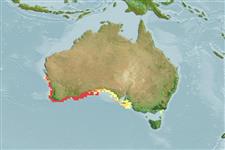Environment: milieu / climate zone / depth range / distribution range
นิเวศวิทยา
เกี่ยวกับทะเล,น้ำเค็ม เกี่ยวกับหินโสโครก; ไม่มีการอพยพย้ายถิ่น. Temperate; 28°S - 39°S, 112°E - 155°E (Ref. 56294)
Eastern Indian Ocean: Endemic to southern Australia (Western Australia and South Australia).
ขนาด / น้ำหนัก / Age
Maturity: Lm ? range ? - ? cm
Max length : 50.0 cm TL เพศผู้/กระเทย; (Ref. 33839)
Occurs inshore (Ref. 7300). Benthic (Ref. 75154). Neither opercular spine nor anterolateral glandular grooves with venom gland is present (Ref. 57406).
Life cycle and mating behavior
Maturities | การสืบพันธุ์ | Spawnings | Egg(s) | Fecundities | ตัวอ่อน
Paxton, J.R., D.F. Hoese, G.R. Allen and J.E. Hanley, 1989. Pisces. Petromyzontidae to Carangidae. Zoological Catalogue of Australia, Vol. 7. Australian Government Publishing Service, Canberra, 665 p. (Ref. 7300)
IUCN Red List Status (Ref. 130435)
Human uses
เครื่องมือ
Special reports
Download XML
แหล่งที่มาจากอินเตอร์เน็ต
Estimates based on models
Preferred temperature (Ref.
123201): 16.8 - 21.7, mean 18 °C (based on 108 cells).
Phylogenetic diversity index (Ref.
82804): PD
50 = 0.5005 [Uniqueness, from 0.5 = low to 2.0 = high].
ระดับชั้นอาหาร (Ref.
69278): 4.1 ±0.7 se; based on size and trophs of closest relatives
ความสามารถในการกลับคืนสู่ปกติ (Ref.
120179): ขนาดกลาง, เวลาต่ำสุดที่จะทำให้ประชากรเพิ่มขึ้นเป็น 2 เท่าใช้เวลา 1.4 - 4.4 ปี (Preliminary K or Fecundity.).
Fishing Vulnerability (Ref.
59153): Moderate vulnerability (40 of 100).
Nutrients (Ref.
124155): Calcium = 9.99 [5.22, 21.76] mg/100g; Iron = 0.168 [0.081, 0.313] mg/100g; Protein = 17.9 [15.2, 20.9] %; Omega3 = 0.41 [0.22, 0.73] g/100g; Selenium = 7.73 [3.60, 16.84] μg/100g; VitaminA = 63.6 [17.2, 279.0] μg/100g; Zinc = 0.464 [0.298, 0.718] mg/100g (wet weight);
